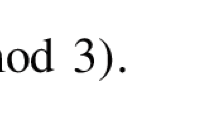Abstract
To a modular form, we propose to associate \((\)an infinite number of\()\) complex-valued functions on \(p\)-adic numbers \(\mathbb{Q}_p\) for each prime \(p\). We elaborate on the correspondence and study its consequences in terms of the Mellin transform and the \( L \)-function related to the form. Further, we discuss the case of products of Dirichlet \( L \)-functions and their Mellin duals, which are convolution products of \(\vartheta\)-series. The latter are intriguingly similar to nonholomorphic Maass forms of weight zero as suggested by their Fourier coefficients.
Similar content being viewed by others
Notes
More precisely, the relevant groups are the projective special linear groups \(PSL(2,\mathbb{R})=SL(2,\mathbb{R}/\{\pm\}\)) and \(PSL(2,\mathbb{Z})=SL(2,\mathbb{Z})/\{\pm 1\}\).
A Dirichlet character (modulo \(N\)) is a group homomorphism \(\chi_{{}_N}\in Hom(G(N),\mathbb{C}^*)\) from the multiplicative group \(G(N)=(\mathbb{Z}/N\mathbb{Z})^*\) of invertible elements of \(\mathbb{Z}/N\mathbb{Z}\) to \(\mathbb{C}^*\). It is a multiplicative character. It is customarily extended to all integers by setting \(\chi_{{}_N}(m)=0\) for all \(m\) that share common factors with \(N\) [14].
By an abuse of notation, we continue to use the same symbol for the restrictions of the raising and lowering operators to \(\mathcal H^{(p)}_{-}\). Because it is the subspace that is of primary interest to us, this should hopefully not be a cause of confusion.
We became aware of these results after submitting a version of this paper to the arXiv.
References
A. Dabholkar, “Ramanujan and quantum black holes”; arXiv: 1905.04060.
A. Dabholkar and S. Nampuri, “Quantum black holes,” in: Strings and Fundamental Physics (Munich/Garching, Germany, July 25 – August 6, 2010, Lecture Notes in Physics, Vol. 851, M. Baumgartl, I. Brunner, and M. Haack, eds.), Springer, Berlin (2012), pp. 165–232; arXiv: 1208.4814.
H. M. Edwards, Riemann’s Zeta Function, Dover, Mineola, NY (2001).
P. Dutta and D. Ghoshal, “Pseudodifferential operators on \(\mathbf{Q}_p\) and \(L\)-series,” accepted for publication in \(p\)-Adic Numbers Ultrametric Anal. Appl.; arXiv: 2003.00901.
V. Vladimirov, I. Volovic, and E. Zelenov, \(p\)-Adic Analysis and Mathematical Physics, (Series On Soviet and East European Mathematics, Vol. 1), World Sci., Singapore (1994).
S. V. Kozyrev, “Wavelet theory as \(p\)-adic spectral analysis,” Izv. Math., 66, 367–376 (2002); arXiv: math-ph/0012019.
A. Chattopadhyay, P. Dutta, S. Dutta, and D. Ghoshal, “Matrix model for Riemann zeta via its local factors,” Nucl. Phys. B, 954, 114996, 37 pp. (2020); arXiv: 1807.07342.
D. Spector, “Supersymmetry and the Möbius inversion function,” Commun. Math. Phys., 127, 239–252 (1990).
B. Julia, “Statistical theory of numbers,” in: Number Theory and Physics (Proceedings of the Winter School, Les Houches, France, August 7–16, 1989, Springer Proceedings in Physics, Vol. 47, J.-M. Luck, P. Moussa, and M. Waldschmidt, eds.), Springer, Berlin (1990), pp. 276–293.
I. Bakas and M. Bowick, “Curiosities of arithmetic gases,” J. Math. Phys., 32, 1881–1884 (1991).
B. L. Julia, “Thermodynamic limit in number theory: Riemann–Beurling gases,” Phys. A, 203, 425–436 (1994).
P. Dutta and D. Ghoshal, “Phase operator on \(L^2(\mathbb{Q}_p)\) and the zeroes of Fisher and Riemann,” in: Advances in Non-Archimedean Analysis and Applications. The \(p\)-adic Methodology in STEAM-H (STEAM-H: Science, Technology, Engineering, Agriculture, Mathematics & Health, W. Zúñiga-Galindo and Bourama Toni, eds.), Springer, Cham, Switzerland (2021).
J. Lewis and D. Zagier, “Period functions for Maass wave forms. I,” Ann. Math., 153, 191–258 (2001).
J.-P. Serre, A Course in Arithmetic, (Graduate Texts in Mathematics, Vol. 7), Springer, New York, Heidelberg (1973).
N. I. Koblitz, Introduction to Elliptic Curves and Modular Forms, (Graduate Texts in Mathematics, Vol. 97), Springer, New York (1993).
E. J. Warner, “Modular forms and \(L\)-functions: a crash course,” https://www.math.columbia.edu/\(\sim\)warner/notes/ ClassicalModularForms.pdf.
A. Sutherland, “Modular forms and \(L\)-functions,” https://dspace.mit.edu/bitstream/handle/1721.1/97521/18-783-spring-2013/contents/.
I. I. Pyatetskii-Shapiro, I. M. Gel’fand, and M. I. Graev, Representation Theory and Automorphic Functions (Saunders Mathematics Books), W. B. Saunders Company, Philadelphia (1968).
A. Yu. Khrennikov, S. V. Kozyrev, and W. A. Zúñiga-Galindo, Ultrametric Pseudodifferential Equations and Applications (Encyclopedia Math. Appl., Vol. 168), Cambridge Univ. Press, Cambridge (2018).
P. Dutta, D. Ghoshal, and A. Lala, “Enhanced symmetry of the \(p\)-adic wavelets,” Phys. Lett. B, 783, 421–427 (2018); arXiv: 1804.00958.
D. Goldfeld and J. Hundley, Automorphic Representations and \(L\)-Functions for the General Linear Group, Vol. 1, (Cambridge Studies in Advanced Mathematics, Vol. 129), Cambridge Univ. Press, Cambridge (2011).
J. B. Conrey, W. Duke, and D. W. Farmer, “The distribution of the eigenvalues of Hecke operators,” Acta Arith., 78, 405–409 (1997); arXiv: math/9609214.
J.-P. Serre, “Répartition asymptotique des valeurs propres de l’opérateur de Hecke \(T_p\),” J. Amer. Math. Soc., 10, 75–102 (1997).
T. M. Apostol, Introduction to Analytical Number Theory, Springer, New York (1976).
I. S. Gradshteyn and I. M. Ryzhik, Table of Integrals, Series, and Products, Academic Press, New York (2014).
Acknowledgments
One of us (DG) presented a preliminary version of some of these results (as well as those in [4]) at the National String Meeting 2019 held at IISER Bhopal, India during December 22–27, 2019. We would like to thank Chandan Singh Dalawat and Vijay Patankar for the useful discussions. We are particularly grateful to Krishnan Rajkumar for many patient explanations and valuable comments on the manuscript.
Funding
D. Ghoshal is supported in part by the Mathematical Research Impact Centric Support (MATRICS) of the Science and Engineering Research Board, Department of Science and Technology, Government of India (grant no. MTR/2020/000481).
Author information
Authors and Affiliations
Corresponding author
Ethics declarations
The authors declare no conflicts of interest.
Additional information
Translated from Teoreticheskaya i Matematicheskaya Fizika, 2021, Vol. 209, pp. 101–124 https://doi.org/10.4213/tmf10108.
Appendix: Wavelets on $$\pmb{\mathbb{Q}}_p^\times$$
We modify the Kozyrev wavelets to define
Rights and permissions
About this article
Cite this article
Dutta, P., Ghoshal, D. A \(p\)-arton model for modular cusp forms. Theor Math Phys 209, 1403–1422 (2021). https://doi.org/10.1134/S0040577921100068
Received:
Revised:
Accepted:
Published:
Issue Date:
DOI: https://doi.org/10.1134/S0040577921100068



